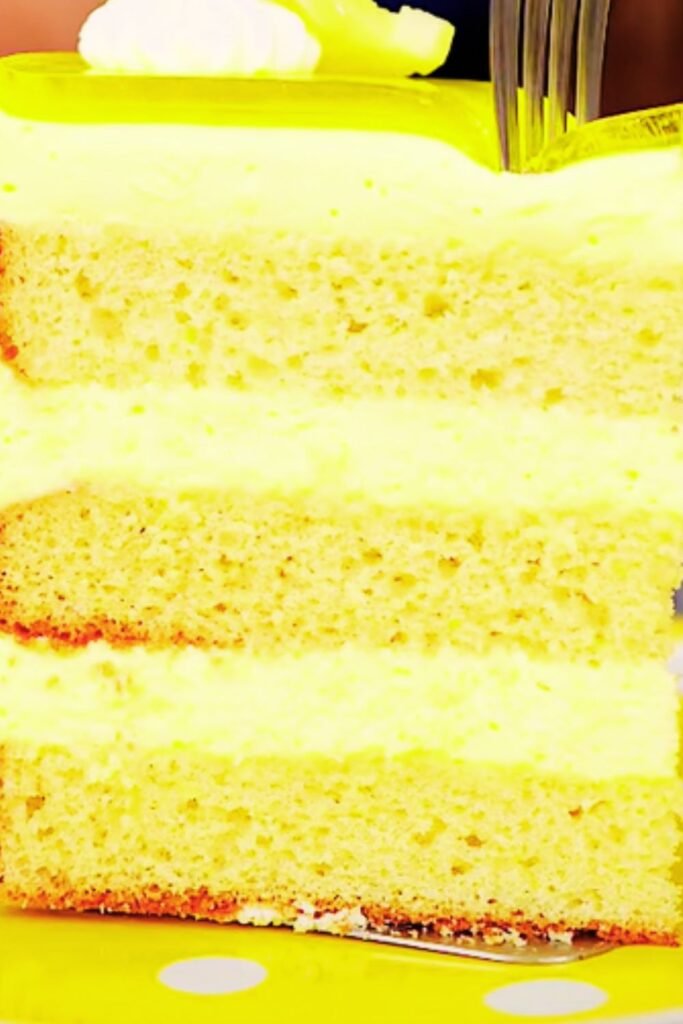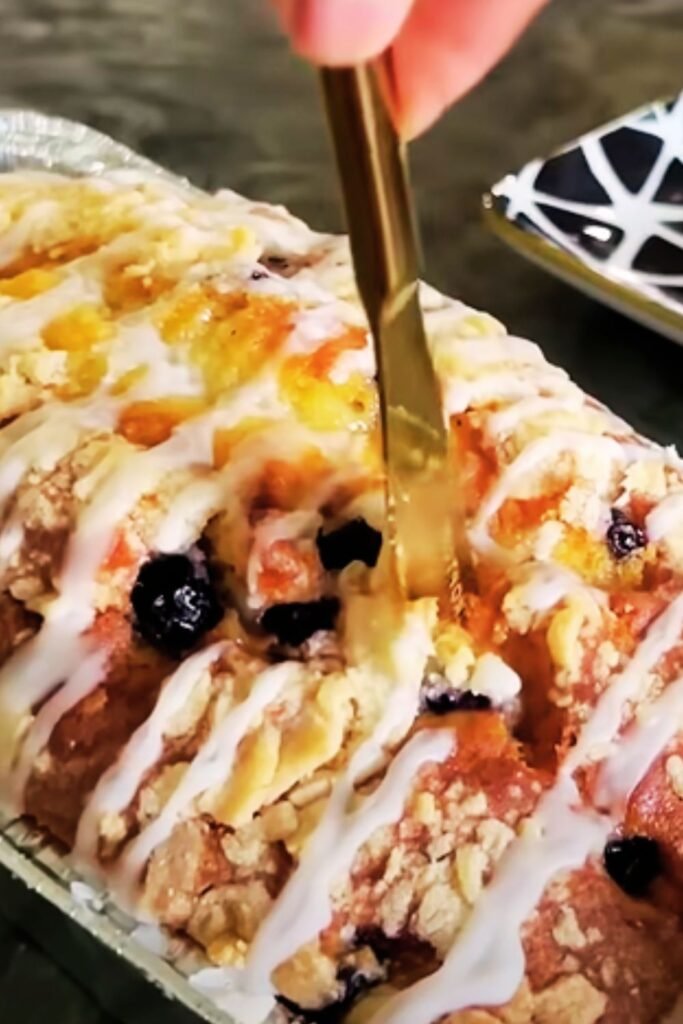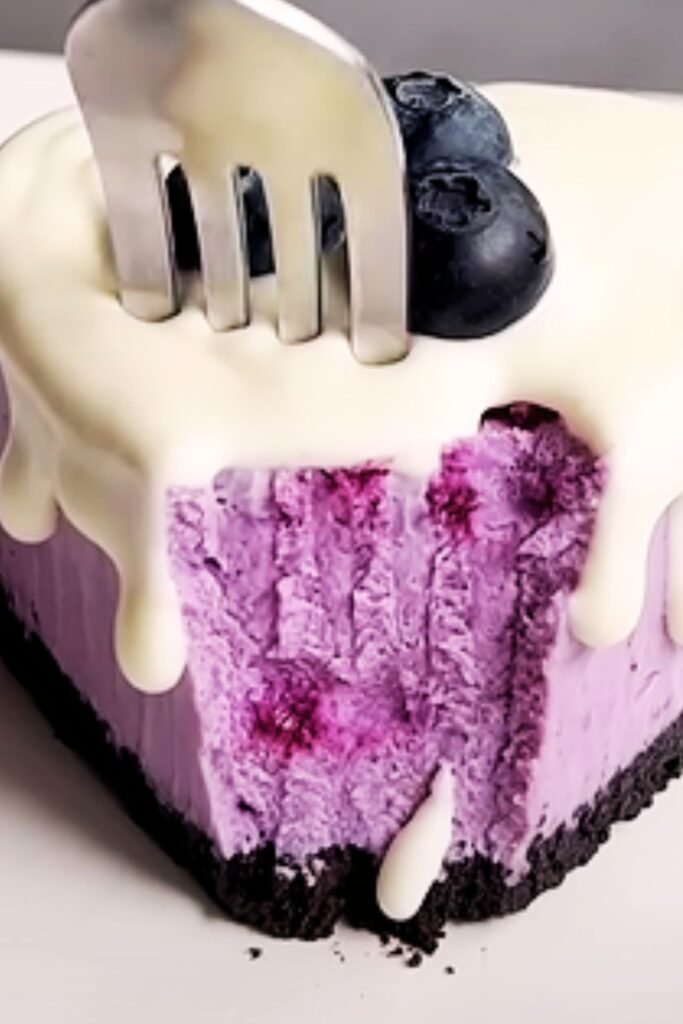There’s something magical about the combination of tart lemons, sweet blueberries, and buttery shortbread that makes my heart sing every time I create this dessert. I’ve been perfecting this Lemon Blueberry Shortbread Mousse Cake recipe for years, and I can honestly say it’s become my signature dessert for special occasions. The layers of flavor and texture create an experience that goes far beyond ordinary cake – it’s truly a symphony of flavors that will leave your guests asking for the recipe.
When I first developed this recipe, I wanted to combine the best elements of traditional shortbread cookies, airy mousse, and the classic pairing of lemon and blueberry. What emerged was this stunning three-layer masterpiece that balances sweet, tart, creamy, and crunchy textures in perfect harmony. The buttery shortbread base provides a sturdy foundation, while the lemon mousse adds brightness and the blueberry component brings natural sweetness and vibrant color.
Understanding the Components
Before diving into the recipe, let me explain the key elements that make this dessert so special:
Shortbread Base : A traditional Scottish cookie made with butter, flour, and sugar that serves as the foundation layer. The high butter content creates a tender, crumbly texture that melts in your mouth.
Lemon Mousse : A light, airy mixture combining lemon curd, whipped cream, and gelatin to create a fluffy, stable layer that won’t collapse under the weight of toppings.
Blueberry Compote : Fresh or frozen blueberries cooked down with sugar and a touch of lemon juice to create a jammy consistency that complements both the shortbread and mousse.
Stabilized Whipped Cream : Heavy cream whipped with a small amount of gelatin or cornstarch to maintain its shape and prevent weeping over time.
The beauty of this cake lies in its versatility. I’ve served it at summer garden parties, elegant dinner gatherings, and casual family celebrations. Each time, it receives rave reviews and becomes the centerpiece of conversation.
Essential Ingredients and Their Roles
Creating the perfect Lemon Blueberry Shortbread Mousse Cake requires understanding how each ingredient contributes to the final result. I’ve learned through trial and error that quality ingredients make all the difference in this recipe.
Shortbread Layer Ingredients
| Ingredient | Amount | Purpose | Quality Tips |
|---|---|---|---|
| Unsalted Butter | 1 cup (226g) | Creates tender, flaky texture | Use European-style butter for richer flavor |
| All-Purpose Flour | 2 cups (240g) | Provides structure | Sift for lighter texture |
| Powdered Sugar | ½ cup (60g) | Sweetens and tenderizes | Creates finer crumb than granulated sugar |
| Vanilla Extract | 1 teaspoon | Enhances overall flavor | Pure vanilla extract only |
| Salt | ¼ teaspoon | Balances sweetness | Fine sea salt works best |
Lemon Mousse Components
| Ingredient | Amount | Function | Selection Guide |
|---|---|---|---|
| Fresh Lemon Juice | ¾ cup (180ml) | Provides tartness | Use Meyer lemons for milder flavor |
| Lemon Zest | 3 tablespoons | Intensifies lemon flavor | Microplane grater works best |
| Unflavored Gelatin | 2 packets | Stabilizes mousse | Bloom in cold water first |
| Heavy Cream | 2 cups (480ml) | Creates light texture | 35% fat content minimum |
| Granulated Sugar | ¾ cup (150g) | Balances acidity | Superfine sugar dissolves easier |
| Egg Yolks | 6 large | Adds richness | Room temperature works best |
Blueberry Layer Elements
| Ingredient | Quantity | Role | Best Practices |
|---|---|---|---|
| Fresh Blueberries | 2 cups (300g) | Main flavor component | Look for firm, plump berries |
| Sugar | ⅓ cup (65g) | Sweetens and helps thicken | Adjust based on berry sweetness |
| Cornstarch | 2 tablespoons | Thickening agent | Mix with cold water first |
| Lemon Juice | 1 tablespoon | Brightens flavor | Fresh squeezed only |

Step-by-Step Construction Process
I’ve refined this process over countless attempts, and I can tell you that timing and technique are crucial for success. Each layer needs proper attention and care to achieve the perfect result.
Preparing the Shortbread Foundation
The shortbread base sets the stage for everything that follows. I start by preheating my oven to 325°F (163°C) and lining a 9-inch springform pan with parchment paper. The lower temperature ensures even baking without over-browning.
In my stand mixer, I cream together room-temperature butter and powdered sugar until light and fluffy – this takes about 4-5 minutes on medium speed. I then add vanilla extract and salt, mixing just until combined. The flour goes in last, and I mix on low speed only until the dough comes together. Overmixing develops gluten, which creates tough shortbread.
I press the dough evenly into the prepared pan, creating a slight rim around the edges. Using the bottom of a measuring cup helps achieve uniform thickness. After pricking the surface with a fork to prevent puffing, I bake for 22-25 minutes until the edges are lightly golden. The center should still appear slightly underbaked – it will continue cooking from residual heat.
Creating the Perfect Lemon Mousse
While the shortbread cools, I prepare the lemon mousse. This component requires patience and attention to temperature to achieve the ideal texture.
I start by blooming gelatin in ¼ cup cold water for 5 minutes. Meanwhile, I whisk egg yolks and sugar in a heavy-bottomed saucepan until pale yellow. The lemon juice and zest go in next, followed by gentle heating over medium-low heat while whisking constantly.
The mixture needs to reach 170°F (77°C) to properly thicken – I use an instant-read thermometer to monitor this carefully. Once it coats the back of a spoon, I remove it from heat and whisk in the bloomed gelatin until completely dissolved.
After straining the mixture through a fine-mesh sieve to remove any lumps, I let it cool to room temperature while occasionally stirring. In a separate bowl, I whip heavy cream to soft peaks – not stiff peaks, as they’ll break down when folded in.
The key to successful mousse is folding technique. I add one-third of the whipped cream to the lemon mixture to lighten it, then gently fold in the remaining cream in two additions. This preserves the airy texture while ensuring even distribution.

Preparing the Blueberry Component
The blueberry layer adds both flavor and visual appeal to the finished cake. I prefer using a combination of fresh and cooked blueberries for varied texture.
In a medium saucepan, I combine half the blueberries with sugar and lemon juice over medium heat. As the berries release their juices, I gently mash some of them while leaving others whole for texture variation. The mixture simmers for 8-10 minutes until it reaches a jammy consistency.
I dissolve cornstarch in 2 tablespoons cold water and stir it into the berry mixture. This thickens the compote and prevents it from making the cake soggy. After another 2-3 minutes of cooking, I remove it from heat and fold in the remaining fresh berries. The mixture cools completely before assembly.
Assembly Techniques and Tips
Assembly requires careful layering and proper chilling between steps. I’ve learned that rushing this process leads to layers mixing together instead of maintaining distinct boundaries.
Once the shortbread base has cooled completely, I spread the lemon mousse evenly over the surface using an offset spatula. The mousse should reach almost to the rim but not overflow. I then refrigerate the cake for at least 2 hours to set the mousse before adding the blueberry layer.
The blueberry compote goes on next, spread gently to avoid disturbing the mousse underneath. I reserve some of the prettiest whole berries for final decoration. Another hour of chilling helps everything set properly.
For the final touch, I prepare stabilized whipped cream by dissolving ½ teaspoon unflavored gelatin in 1 tablespoon warm water, then whisking it into 1 cup heavy cream while whipping to soft peaks. This creates a stable topping that won’t weep or deflate over time.
Nutritional Profile and Serving Information
Understanding the nutritional aspects of this dessert helps with meal planning and portion control. While it’s definitely an indulgent treat, the fresh fruit components do provide some nutritional benefits.
Nutritional Breakdown Per Serving (12 servings)
| Nutrient | Amount | % Daily Value | Health Notes |
|---|---|---|---|
| Calories | 385 | 19% | Moderate for dessert portion |
| Total Fat | 22g | 28% | Primarily from butter and cream |
| Saturated Fat | 14g | 70% | Rich dessert – serve small portions |
| Cholesterol | 145mg | 48% | From eggs and dairy |
| Sodium | 95mg | 4% | Relatively low sodium content |
| Carbohydrates | 45g | 15% | Natural and added sugars |
| Fiber | 2g | 8% | From blueberries and flour |
| Sugar | 32g | – | Natural fruit sugars plus added |
| Protein | 5g | 10% | From eggs and dairy |
| Vitamin C | 12mg | 13% | From lemon juice and blueberries |
| Antioxidants | – | – | Significant from blueberries |
The blueberries provide anthocyanins, powerful antioxidants that support heart health and cognitive function. Lemons contribute vitamin C and citrus flavonoids. While this dessert is calorie-dense, the portion size allows for enjoyment without excessive indulgence.

Troubleshooting Common Issues
Over the years, I’ve encountered various challenges while perfecting this recipe. Here are the most common problems and my solutions:
Shortbread Base Problems
- Too crumbly: Usually means insufficient butter or overmixing. Ensure butter is properly creamed and don’t overwork the dough.
- Too hard: Often from overbaking or using cold butter. Bake just until edges are set and always use room-temperature butter.
- Uneven browning: Oven hot spots cause this. Rotate the pan halfway through baking and consider using an oven thermometer.
Mousse Texture Issues
- Grainy texture: Temperature too high when cooking egg mixture. Keep heat low and stir constantly.
- Won’t set: Gelatin wasn’t properly bloomed or dissolved. Always bloom in cold water first, then dissolve completely in warm mixture.
- Deflated appearance: Overwhipped cream or too vigorous folding. Whip cream to soft peaks only and fold gently.
Blueberry Layer Concerns
- Too runny: Insufficient cooking time or cornstarch not properly activated. Simmer until thickened and ensure cornstarch is dissolved.
- Too thick: Overcooked or too much thickener. Add a tablespoon of water or lemon juice to thin.
- Bleeding color: Fresh berries added too warm. Cool compote completely before folding in fresh berries.
Storage and Make-Ahead Strategies
This cake actually improves with time, making it perfect for entertaining. I often prepare it a day ahead, which allows the flavors to meld beautifully.
The assembled cake keeps in the refrigerator for up to 4 days when properly covered. I use plastic wrap directly on the surface, then cover the entire pan with foil to prevent absorption of refrigerator odors.
For longer storage, individual components can be prepared separately:
- Shortbread base freezes for up to 3 months wrapped tightly
- Lemon mousse keeps refrigerated for 2 days before assembly
- Blueberry compote stays fresh for 1 week in the refrigerator
When serving, I remove the cake from refrigeration 15-20 minutes before cutting. This slight tempering makes slicing cleaner and enhances the flavors. A sharp, thin knife dipped in warm water between cuts creates the cleanest slices.
Seasonal Variations and Adaptations
While I love the classic lemon-blueberry combination, this base recipe adapts beautifully to other seasonal fruits and flavors.
Spring Variations
- Replace blueberries with strawberry-rhubarb compote
- Use orange zest and juice instead of lemon for a different citrus profile
- Add fresh mint to the berry layer for a garden-fresh taste
Summer Adaptations
- Mixed berry versions using raspberries, blackberries, and blueberries
- Peach and lemon combination for a Southern twist
- Cherry-lemon variation using sweet cherries
Fall Options
- Apple-cinnamon compote with lemon mousse
- Pear and ginger combination
- Cranberry-orange version for holiday entertaining
Winter Modifications
- Blood orange mousse with traditional blueberries
- Pomegranate seeds for jewel-like color
- Candied citrus peel additions for elegant presentation
Each variation follows the same basic technique while adjusting flavoring components. The structural elements remain consistent, ensuring success regardless of seasonal adaptations.
Professional Presentation Tips
Presentation elevates this dessert from homemade treat to restaurant-quality creation. I’ve developed several techniques that create impressive visual impact.
For clean removal from the springform pan, I run a thin knife around the edges before releasing the spring mechanism. A large, flat spatula helps transfer the cake to a serving platter without breaking the delicate layers.
Garnishing makes a significant difference in final appearance. I arrange fresh blueberries in concentric circles on top, dust lightly with powdered sugar, and add thin lemon zest curls created with a channel knife. Mint sprigs provide color contrast and fresh aroma.
When serving at parties, I pre-slice the cake and arrange individual portions on dessert plates. This prevents the serving area from becoming messy and ensures each guest receives a perfect slice with all layers intact.
Frequently Asked Questions
Q: Can I make this cake without gelatin for vegetarian guests?
I understand dietary restrictions, and yes, you can substitute agar-agar for gelatin using about half the amount. However, the texture will be slightly different – less creamy and more firm. Another option is using cornstarch as a stabilizer, though this creates a pastry cream texture rather than true mousse.
Q: What’s the best way to prevent the layers from sliding apart when cutting?
Proper chilling is crucial – the cake needs at least 4 hours of refrigeration, preferably overnight. I also recommend using a sharp, thin knife dipped in warm water between each cut. Clean the blade frequently to prevent dragging filling between layers.
Q: Can I substitute frozen blueberries for fresh ones?
Absolutely! Frozen blueberries actually work wonderfully in the compote because they break down more readily, creating natural thickening. Don’t thaw them first – add them frozen to the saucepan. You might need slightly less sugar since frozen berries are often sweeter than fresh.
Q: How do I know when the lemon curd is properly cooked?
The mixture should coat the back of a spoon and hold a line when you draw your finger through it. Temperature-wise, aim for 170°F (77°C). If you don’t have a thermometer, look for gentle bubbling around the edges and a noticeable thickening that happens relatively quickly.
Q: Why does my shortbread base sometimes turn out tough?
Tough shortbread usually results from overworking the dough or using cold butter. The butter should be room temperature and creamed properly with the sugar. When adding flour, mix just until combined – overmixing develops gluten, creating toughness.
Q: Can I make individual portions instead of one large cake?
This recipe adapts beautifully to individual serving sizes! Use 4-inch springform pans or even mason jars for a rustic presentation. Adjust baking time for the shortbread to about 15-18 minutes, and assembly follows the same process in smaller quantities.
Q: What’s the ideal serving size for this rich dessert?
I typically cut this cake into 12 generous servings, though it could easily serve 16 smaller portions. The richness means a little goes a long way, and smaller slices actually allow guests to savor the complex flavors without feeling overwhelmed.
Q: How far in advance can I prepare this for entertaining?
This is actually better when made ahead! I prepare it up to 2 days before serving, which allows all the flavors to meld together beautifully. The texture also improves as the layers set properly. Just add final garnishes shortly before serving to maintain their fresh appearance.
This Lemon Blueberry Shortbread Mousse Cake represents everything I love about baking – the perfect balance of technique and creativity, the satisfaction of creating something beautiful and delicious, and the joy of sharing it with others. Every time I serve this dessert, I’m reminded why I fell in love with baking in the first place. The combination of buttery shortbread, bright lemon mousse, and sweet-tart blueberries creates a symphony of flavors that never fails to impress.
Whether you’re preparing this for a special celebration or simply want to treat yourself and your loved ones to something extraordinary, this recipe delivers consistent, stunning results. Take your time with each layer, enjoy the process, and prepare to receive countless compliments on your culinary masterpiece.